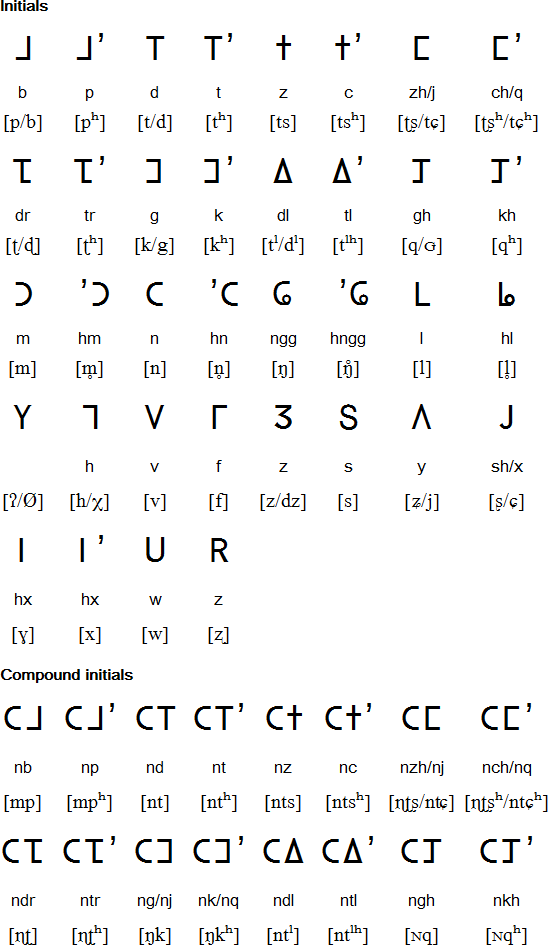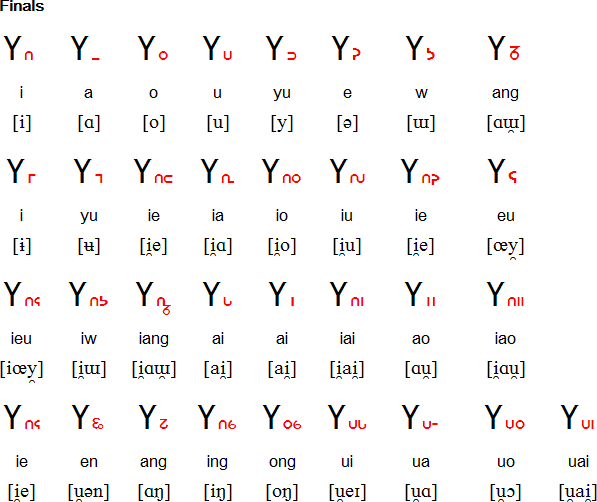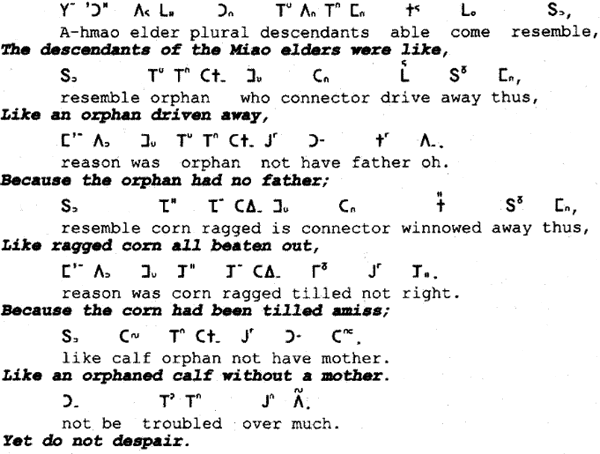The Pollard script, which is also known as Pollard Miao or Miao, was devised in 1905 by Samuel Pollard (1864-1915), a British missionary, with help from Yang Yage and Li Shitifan. Before Pollard came along, the A-Hmao language, when written at all, was written with Chinese characters. Pollard Miao underwent many changes and revisions and only became stable in 1936, when a translation of the New Testament was published in the Pollard script.
The authorities in Beijing were not too keen on a spelling system devised by Western missionaries in Laos in the 1950s - the Romanized Popular Alphabet (RPA). Therefore in 1957 the Chinese government introduced an alternative system based on Hànyŭ Pīnyīn. This was not popular among the A-Hmao people, who were already familiar with the Pollard system.
Various efforts have been made to improve Pollard Miao writing, which inadequately represents the phonetics and tones of A-Hmao and is not ideal for writing Chinese loan words. A semi-official 'reformed' Pollard script has been in use since 1988, along with the older version of the script, and the pīnyīn version.
This chart shows the Pollard script with the Pinyin equivalents of each letter and IPA transcriptions of the pronunciation.




Source: http://syllabics.net/files/cree/two_related_indigenous_writing_systems.pdf
Information about: Hmong | Hmong Dau | Hmong Njua | Scripts for Hmong: Pahawh Hmong | Romanized Popular Alphabet | Pollard Miao | Nyiakeng Puachue Hmong | Phrases in: Hmong Dau | Numbers in: Hmong Dau | Iu Mien | Tower of Babel in: Hmong Dau | Hmong Njua | Iu Mien | Books about Hmong
Information about the Pollard script
http://en.wikipedia.org/wiki/Pollard_script
http://www.archives.ecs.soton.ac.uk/miao/WritingMiao/m001eqv.pdf
http://www.hmonglanguage.net/index.php/ntawv-pollard
A-chik Tokbirim, Adinkra, ADLaM, Armenian, Avestan, Avoiuli, Bactrian, Bassa (Vah), Beitha Kukju, Beria (Zaghawa), Borama / Gadabuursi, Carian, Carpathian Basin Rovas, Chinuk pipa, Chisoi, Coorgi-Cox, Coptic, Cyrillic, Dalecarlian runes, Elbasan, Etruscan, Faliscan, Fox, Galik, Georgian (Asomtavruli), Georgian (Nuskhuri), Georgian (Mkhedruli), Glagolitic, Global Alphabet, Gothic, Greek, Hurûf-ı munfasıla, Irish (Uncial), Kaddare, Kayah Li, Khatt-i-Badíʼ, Khazarian Rovas, Koch, Korean, Latin, Lepontic, Luo Lakeside Script, Lycian, Lydian, Manchu, Mandaic, Mandombe, Marsiliana, Medefaidrin, Messapic, Mongolian, Mro, Mundari Bani, Nag Chiki, Naasioi Otomaung, N'Ko, North Picene, Novo Tupi, Nyiakeng Puachue Hmong, Odùduwà, Ogham, Old Church Slavonic, Oirat Clear Script, Ol Chiki (Ol Cemet' / Santali), Old Italic, Old Nubian, Old Permic, Ol Onal, Orkhon, Osage, Oscan, Osmanya (Somali), Pau Cin Hau, Phrygian, Pollard script, Runic, Székely-Hungarian Rovás (Hungarian Runes), South Picene, Sutton SignWriting, Sunuwar, Tai Viet, Tangsa, Todhri, Toto, Umbrian, (Old) Uyghur, Wancho, Yezidi, Zoulai
Page last modified: 15.03.23
[top]
You can support this site by Buying Me A Coffee, and if you like what you see on this page, you can use the buttons below to share it with people you know.

If you like this site and find it useful, you can support it by making a donation via PayPal or Patreon, or by contributing in other ways. Omniglot is how I make my living.
Note: all links on this site to Amazon.com, Amazon.co.uk
and Amazon.fr
are affiliate links. This means I earn a commission if you click on any of them and buy something. So by clicking on these links you can help to support this site.
[top]